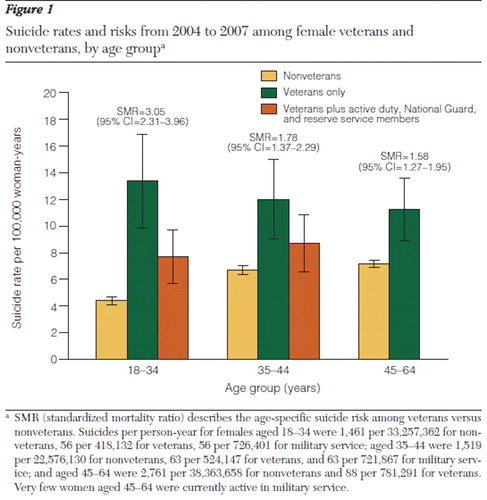Datapoints: Self-Inflicted Deaths Among Women With U.S. Military Service: A Hidden Epidemic?
Prospective analyses of National Health Interview Survey and National Death Index data found an adjusted risk of suicide among male veterans twice that of nonveteran males ( 1 ). That study also examined data for 11 female veterans and 246 female nonveterans who completed suicide and found that women with past military service were more likely to complete suicide (adjusted hazard ratio=3.62, 95% confidence interval [CI]=1.95–6.73).
This cross-sectional study used 2004–2007 data for 5,948 women (ages 18 to 64) who completed suicide in the 16 states that constitute the National Violent Death Reporting System. Denominators were from 2004–2007 veteran population data and American Community Surveys. We examined rates for female nonveterans and veterans, whose rates were computed using two denominators—female veterans and the broader military service population of veterans plus active duty, reserve, and National Guard.
Figure 1 shows standardized mortality ratios (SMRs) for female veterans, who were more likely than nonveterans to complete suicide, even when the broader military service denominator was used (ages 18–34, SMR=1.76, CI=1.32–2.27 and ages 35–44, SMR=1.30, CI=1.00–1.66).

As the first general population study of current suicide risk among women with U.S. military service, limitations included inability to distinguish decedents on active duty versus those who were discharged, presumed undercounting of suicides, absence of data on military sexual trauma or combat exposure, and unavailable data on possible confounders (which were addressed in longitudinal analyses).
These findings suggest a hidden epidemic of suicide among younger women with military service. Clinicians should inquire about military service among women and should recognize that suicide prevention practices pertain to female veterans.
Acknowledgments and disclosures
This study was supported by the American Foundation for Suicide Prevention, with restricted data provided by the Centers for Disease Control and Prevention. Neither organization had any role in study design or conduct.
The authors report no competing interests.
1. Kaplan MS, Huguet N, McFarland BH, et al: Suicide among male veterans: a prospective population-based study. Journal of Epidemiology and Community Health 61:619–624, 2007Google Scholar



